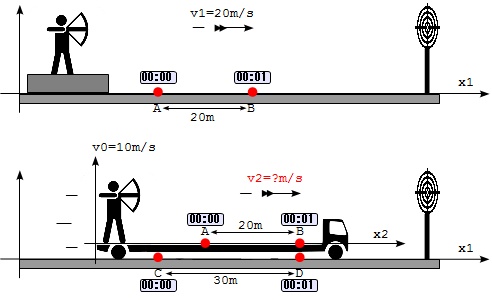Physics Notes - Herong's Tutorial Notes - v3.25, by Herong Yang
Different Speeds Observed in Different Frames
This section describes the dependency of speed on the frame of reference. selecting different frames of reference will result different speeds of the same moving object.
To calculate the speed of a moving object, we need to measure the distance the object has moved within a give duration of time. To measure the distance the object has moved, we need a frame of reference.
This means that selecting different frames of reference will result different speeds of the same moving object. Let's consider the following example.
An archer is going to shoot two arrows to a target. The first arrow will be shot from ground and the second shot from a truck that moves towards the target.
Let's assume that we have a frame of reference fixed on the ground called "x1", and another frame of reference fixed on a truck called "x2".
When the archer stands on ground and shoots the first arrow, we observe that arrow flies 20 meters from A to B in frame x1 for 1 second. So the speed of the arrow is v1 = 20 m/s in frame x1 when shooting from the ground.
Now the archer climbs to the truck that moves towards the target at a speed of 10 m/s observed in frame x1, shoots the second arrow. This time, we can make two observations:
- On the truck, the arrow flies 20 meters from A to B in frame x2 for 1 second.
- On the ground, the arrow flies 30 meters from C to D in frame x1 for 1 second. The extra distance of 10 meters comes from the moving truck.
So the speed of the arrow has 2 values:
- v2 = 20 m/s observed in frame x2 on the truck.
- v2 = 30 m/s observed in frame x1 on the ground.

Table of Contents
Introduction of Frame of Reference
►Different Speeds Observed in Different Frames
Measuring Speed of Light - Roemer's Method
Measuring Speed of Light - Fizeau's Method
Measuring Speed of Light - Foucault's Method
Introduction of Special Relativity
Time Dilation in Special Relativity
Length Contraction in Special Relativity
The Relativity of Simultaneity
Minkowski Spacetime and Diagrams
Introduction of Generalized Coordinates